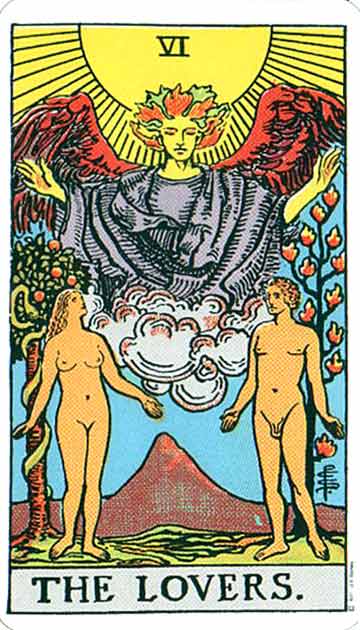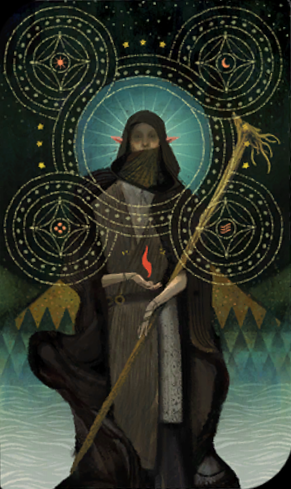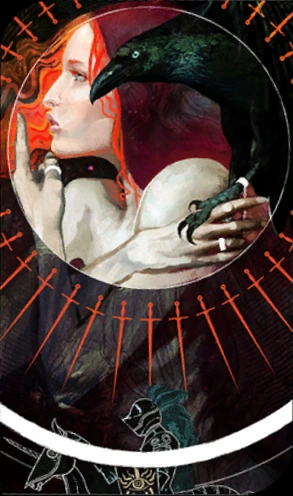Introduction
Although the Solas romance ends rather sadly (or angrily depending on your dialogue choices), the Tarot card that represents Solas after the completion of the romance is actually quite positive. I have read that others name this card the Heirophant, but that does not quite work visually and symbolically or narrative wise. Many fans have noticed that Solas's romance card and the inquisitor female elf card mirror each other, and I do not think this mirroring is accidental. It fact, its noticeable enough that there are many fan made edits like this one, below.
It's important to note here that ONLY a female elf can romance Solas so while it may not be intentional on the part of Caspar Konefal, it does make sense that this single card would coordinate with Solas's romance card. Here the two figures face each other, almost reaching out. She appears to be growing a branching structure, I'm going to assume is a plant and Solas is reaching out to touch a plant with a reverent look. The mirrored gold leaves, however, were added by the artist.
When the two cards are placed side by side they are facing each other. When reading Tarot cards, the position of the figures on the cards in relation to each other can be very significant in a reading so it is no stretch to consider their orientation. When the figures are facing each other it can mean a collaboration, relationship, or balance of the energies of the two cards. Or they cards may represent actual people in which they have a collaborative relationship, union, or even romantic relationship.
Traditional Interpretation & Description of The Lovers:
The Lovers card depicts a man and a woman standing, each with a tree growing behind them and an angel with fiery hair hovering above them. In the background is a tall mountain in the distance with water in front of it and high in the sky is a blazing sun. The sun is shining down in warmth and security. The angel has fiery hair and red wings, representing the element fire which is associated with passion, however, this angel is Raphael, the angel of air. The two elements of fire and air in balance in this card makes this union a healthy one. The angel can be interpreted as blessing their union with passion and communication, two ingredients to a healthy romance.
The woman on the card is looking up to the angel, whereas the man is looking at the woman, symbolizing the path of the physical desires to emotional needs to spiritual concerns, the levels involved in a deep romance. The snake in the tree behind the woman is likely a reference to Adam and Eve along with the trees behind them as they are in the garden. The tree behind the man has twelve flames, symbolizing the twelve zodiac signs, a symbol of eternity. The mountain in the background is a phallic symbol which is balanced by the female symbol of the water. The ground they stand on is green and fertile.
Traditionally The Lovers card represents unity, harmony, perfection, love, and choices. The fact that it also represents choices may be a bit of a surprise, but we will get to that later. The balance of the masculine and feminine and the fire and water elements in the card support the interpretation of perfection and balance. The Lovers card does not just represent any love affair; it represents one that is full of trust, deep connection, and very intimate (emotionally and physically). There is a sense of peace in this card, peace that arises from the security and confidence in the relationship.
This card can also represent choices. Some versions of the card show a male figure choosing between two different women, however this version of the card (Rider Waite Smith) also does. Think of it this way; when two people join together in a serious committed relationship they must integrate their lives. You need to choose what stays and what you must let go when having a healthy, happy relationship. Thus, The Lovers card can also represent the need to integrate two possible choices or to let one go in order to move forward. Something must be sacrificed. These choices usually define who the querent is; they are not simple choices but ones that have great weight in determining the querent's identity and value system.
Description of the Dragon Age Solas Card
Solas's romance card has a very peaceful energy to it. Solas is depicted in profile, peacefully touching leaves from a tree. The leaves of the tree are golden and appear to be falling, as they would in autumn. He is wearing fancier clothing than he does through most of the game, with his signature wolf fur over his shoulder and casually holds his staff in the crook of his left arm. Next to him is a white wolf standing next to him, looking rather innocent and facing down. Solas appears to be in a field and behind him is a forest.
Comparison
Like the traditional Lovers card both male and female figures are facing each other, but they are on separate cards. This represents their separation, although they still maintain their deep emotional connection (depending on your dialogue choices this appears to be true for Solas and may also be true for the Inquisitor in the Tresspasser DLC). Like the traditional card they are both next to trees. Plants in Tarot usually represent creativity and fertility, which may be true for the female elf Inquisitor card, but the tree in Solas's card appears to be dropping its golden leaves. The leaves may reflect the dying of the elven culture and society, a garden which Solas can no longer tend. Or it could just be a reference to the flames on the tree in the traditional Lovers card.
Just as the traditional card, Solas's romance card is very peaceful. He is taking his time to interact with nature, the white wolf is at his feet appearing tame, and his facial expression is serene. His body posture also appears relaxed. This may reflect some form of taming or pacifying that the romance has had on Solas. It definitely tamed some of his bigotry towards the people of Thedas, and helped him develop some sympathy for those he will ultimately harm. Hopefully this will lessen the damage he intends to do. It may also provide him some space for inner peace, knowing that this path he is on after Dragon Age Inquisition ends, is not the only one. It may help him know that he does have a choice.
Choices
Like I said before, The Lover's card also traditionally represents choices; important self defining choices that one must make to establish who they are. While Solas chooses to leave after killing Corypheus and the events in Trespasser take place whether you romance Solas or not, your relationship with him may effect the outcome of future Dragon Age games. The choices represented with the Lovers card are choices you must make again and again to define who you are because at no single point in a person's lifetime is a person set and fixed.
When Solas breaks up with you in Crestwood he is making one of these self defining choices. Instead of staying with the Inquisitor, moving on and helping to make this current world a better one, he decides he must not go against who he believes he is, a protector of the elven people, and fight to restore the elven people. Instead of integrating his identity with the Inquisitor or modern Thedas, he tries to discard the part of him that desperately wants to be with the Inquisitor to maintain his own purpose. This is precisely the type of choice that the Lovers card traditionally represents.











